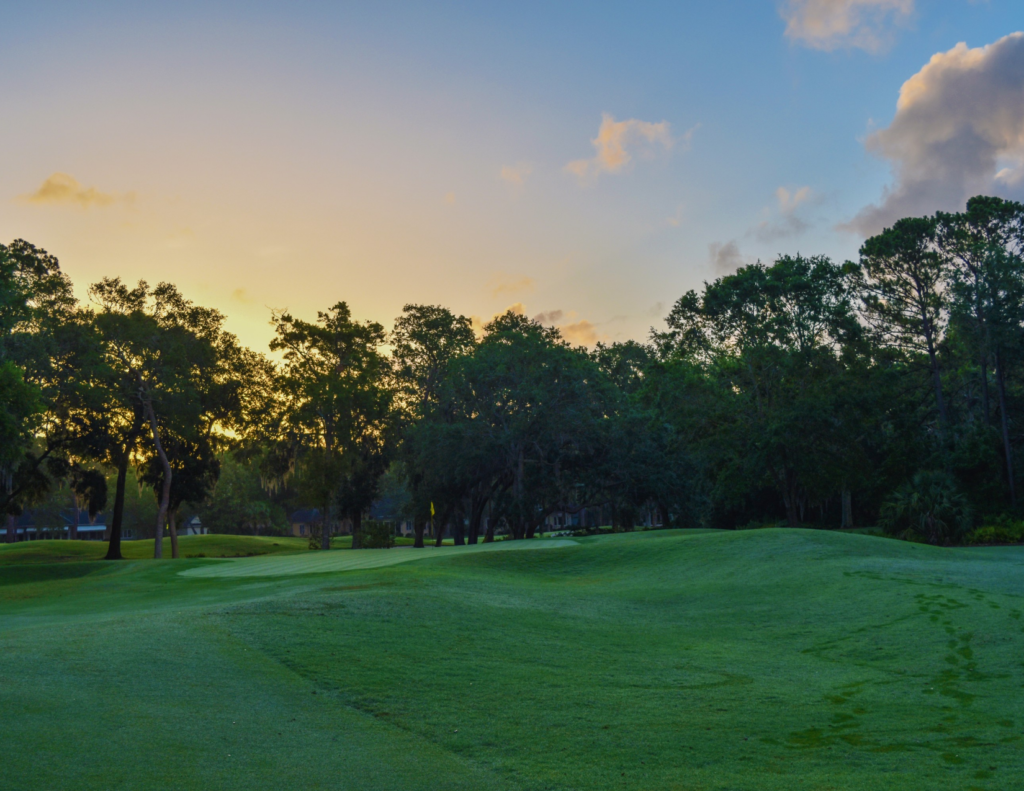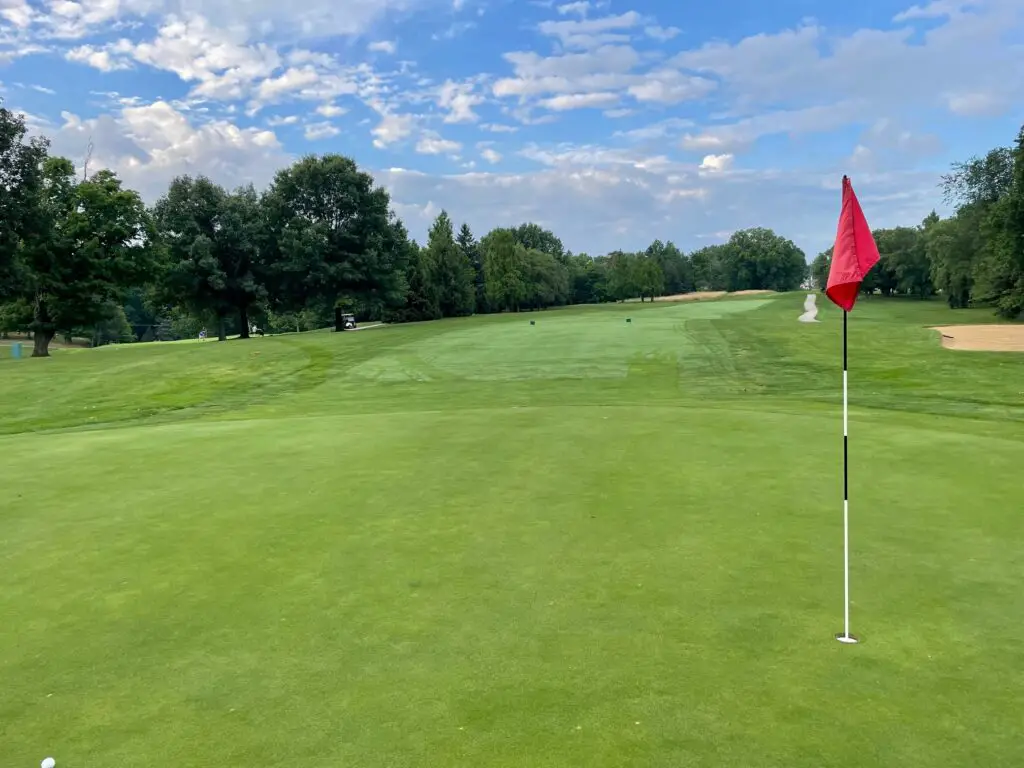On average golfers will hit their 52 degree wedge 100 yards. However, there will be a range depending on the swing speed of the golfer that will most likely fall between 80 and 120 yards.
The 52 degree wedge is a scoring club and a club the golfer should be looking to hit quality shots that provide makeable birdie putts. Of course the golfer needs to be able to control 3 key aspects when hitting the 52 degree wedge:
- The quality of the contact
- The start line of the shot
- The total carry distance
In order to play quality golf, the golfer must be able to control the three factors above with the 52 degree wedge. Birdie putts inside of 30 feet on a regular basis will increase the chance of making more birdies during the round.
How Far Does A 52 Degree Wedge Go: Two Keys
It is one thing to be able to hit your 52 degree wedge 115 yards, but it means nothing if you hit 105 one time and 125 the next. The true key with wedges is dialing in your distances so you can score and leave makeable birdie putts!
The golfer must understand the following:
- How far they carry their 52 degree wedge
- How far the each shot on the course is
To handle these two keys I would recommend using a launch monitor to dial in your distance and have actual numbers (see below for our process).
Second, the golfer should utilize a rangefinder to measure distances to the pin while on the course.
The combination of these two factors: understanding how far you hit each club and having the exact distance helps you score better!
When to use a 52 degree wedge!

52 Degree Wedge: Make These Shots Count
A golfer might only get several shots with this distance on approach shots. For example, on a par 5, they might get a 100 yard shot. Or on a short par 4. It is unlikely that a par 3 will only play 100 yards. This leaves the golfer on average with 2-5 approach shots in this distance depending on their driver distance and the length of the course.
Controlling your distances in golf!
Key #1: 52 Degree Wedge and Quality Contact
To make solid contact the golfer must be able to control the low point of the swing. This can be defined where the club first makes contact with the ground. If the golfer has his or her low point too far behind, they will hit a fat shot and lose distance. If the golfer has a low point too far out in front, they might hit a bladed shot sending the ball flying way too far.
There are several things a golfer can do to improve their low point control:
- Hit thousands of golf balls in one season.
- Practice the low point control drill
Of course, as Ben Hogan said, the secret is in the dirt. Hitting plenty of shots and developing a feel for the club/ground contact point is essential to the long term development. One way to speed this up is through the low point control drill.
Low Point Control Drill
- Take some yard paint and paint a 1-2 yard long line.
- Setup with 55% of your weight on your front side.
- Try to hit the target side of the line and see how many times out of 10 you can do this successfully!
- Repeat this drill every day for a month, tracking your progress and your ability to do this successfully in trials of ten.
- You may need to start with half swing and progress to full swings.
If you are struggling, put more weight forward and work on keeping your head still to help control the low point in the swing.

Key #2: 52 Degree Wedge: The Start Line of the Shot
A well struck 52 degree wedge that flies the right distance, but is 40 fett left of the target might leave you in the bunker or in deep round. The best players are able to control their start line within reason with the 52 degree wedge.
Here is a quick tip: the ball is going to start relative to the direction of the clubface at impact. If the club is pointing left or right, the ball will start left or right and then curve away from the swing path. As a result, the golfer needs to train his or her hands to properly line up the clubface at impact to help produce a quality start line.
Our favorite drill for to train this is the Stock Shot Drill described below:
- At the driving range, set up an alignment stick about 6-8 yards in front of you, straight down your target line.
- If you have a second alignment stick, set the stick 3-4 feet right of the first stick (for a draw) or left of the first stick (for a fade).
- Complete your initial assessment to see how many times out of 10 you can start the ball to the right or left of your target. Pick one side and measure your game at this point.
- The goal is to eventually complete this successfully 7 out of 10 times!
Special Note: With the 52 degree wedge you might not get a significant amount of draw or fade spin on the ball and that is perfectly fine. A shot that falls 1-2 yards left or right can help you eliminate some of the greatest danger on the hole.
I will use the stock shot drill at least once a week to help control my clubface angle and the side spin I am putting on the ball.

Key #3: 52 Degree Wedge: The Total Carry Distance
The perfectly struck shot that is right on-line, but carries 15 yards too far and leaves you with a downhill chip shot from behind the green is a round destroyer. The last think you want is a well struck shot to fly too far, almost guaranteeing you a bogey or worse. Dialing in your distance with all of your wedges is essential to your overall success.
I would highly recommend each golfer create a distance chart like the sample below:
| Club | Carry Distance (100%) | 90% | 80% |
| 2 Utility Iron | 210 | ||
| 4 iron | 190 | ||
| 5 iron | 181 | ||
| 6 iron | 171 | ||
| 7 iron | 163 | ||
| 8 iron | 153 | ||
| 9 iron | 143 | ||
| P Club | 130 | 123 | 115 |
| Pitching Wedge | 118 | 110 | 102 |
| SW Club | 105 | 97 | 91 |
| LW Club | 90 | 82 | 74 |
This might be the most important information you can use to help you play quality golf. I have heard so many stories and have seen it first hand where golfers completely over estimate how far they hit each iron.
They hit one 7 iron 165 yards one time and think this is their carry distance. So they step up to a 165 yard shot, hit the 7 iron and end up in a bunker. They blade it out of the bunker and are looking at a double bogey as their reality. Instead, if they had the right club and hit the 6 iron, their chance of hitting the middle of the green would increase greatly!
How far should you hit a sand wedge?
How can you create your own chart?
Best Option: I would highly recommend a launch monitor!
These portable devices can be used at the driving range, golf course or set up in your home net or golf simulator. These devices are game changers not only on being able to map your bag and know your distances, but they also provide quality feedback after on every shot and provide the following information:
- Carry Distance
- Spin Rate
- Launch Angle
- Spin Axis
- Total Distance
- Ball Speed
This information will help you map your bag, decide on which clubs are best for your game, develop a stock shot and much more. I love using my SkyTrak 365 days a year in my golf simulator setup.
The process for mapping your bag can looking something like this:
- Hit 5 shots with each club in your bag.
- Log the carry distance and total distance for each shot.
- Eliminate any outlier numbers (poor hits or low spin rates).
- Take the average and create a map of your bag.
If you visit any PGA Tour event you will see plenty of golfers utilizing their launch monitors. While most can’t afford a Trackman, there are some very affordable options in the 500-2000 dollar range. I own the SkyTrak and think the world of it.
Here are the top 3 options to check out:

My Secret To Golf Improvement
Let’s face it, in order to get really good at golf, we must practice frequently. About three years ago, I made the leap and invested in a golf simulator build for my garage. I went with a SkyTrak Launch Monitor and the TGC software and can now play over 100,000 courses including Augusta, Pebble Beach, Bethpage Black, Whistling Straits. St. Andrews and many other of the top 100 courses in the world.
This golf simulator setup, which is more affordable that you might imagine, has been a game changer. I can now play golf everyday of the year regardless of rain, snow, cold weather or time of day. I can practice or play rounds of golf. I can stand in the 11th fairway at Augusta and with the auto-rewind feature I am able to practice my approach shots from various differences.
It is worth checking out through Rain or Shine Golf as they offer some incredible packages along with financing offers that are difficult to beat.
Some direct links to Rain or Shine Golf for pricing and financing:
I am an amateur golfer on a journey to get better, enjoy the game as often as possible and share my passion and knowledge with others. I have coached high school golfers at a high level and have a great passion for the game and want to give back. I enjoy learning about the golf swing and am currently studying to be a certified professional golf instructor. Join me in our journey to get better everyday.

